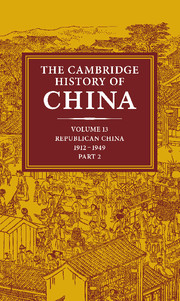Book contents
- Frontmatter
- 1 Introduction: perspectives on modern China's History
- 2 China's international relations 1911–1931
- 3 Nationalist China during the Nanking decade 1927–1937
- 4 The Communist movement 1927–1937
- 5 The agrarian system
- 6 Peasant movements
- 7 The development of local government
- 8 The growth of the academic community 1912–1949
- 9 Literary trends: the road to revolution 1927–1949
- 10 Japanese aggression and China's international position 1931–1949
- 11 Nationalist China during the Sino-Japanese War 1937–1945
- 12 The Chinese Communist movement during the Sino-Japanese War 1937–1945
- 13 The KMT-CCP conflict 1945–1949
- 14 Mao Tse-Tung's thought to 1949
- Bibliographical Essays
- Bibliography
- Conversion table: pinyin to Wade-Giles
- Index
- Republican China - physical features">
- References
5 - The agrarian system
Published online by Cambridge University Press: 28 March 2008
- Frontmatter
- 1 Introduction: perspectives on modern China's History
- 2 China's international relations 1911–1931
- 3 Nationalist China during the Nanking decade 1927–1937
- 4 The Communist movement 1927–1937
- 5 The agrarian system
- 6 Peasant movements
- 7 The development of local government
- 8 The growth of the academic community 1912–1949
- 9 Literary trends: the road to revolution 1927–1949
- 10 Japanese aggression and China's international position 1931–1949
- 11 Nationalist China during the Sino-Japanese War 1937–1945
- 12 The Chinese Communist movement during the Sino-Japanese War 1937–1945
- 13 The KMT-CCP conflict 1945–1949
- 14 Mao Tse-Tung's thought to 1949
- Bibliographical Essays
- Bibliography
- Conversion table: pinyin to Wade-Giles
- Index
- Republican China - physical features">
- References
Summary
The narratives in preceding chapters have concerned China's international relations to 1931 and the fortunes of the Nationalist government in power at Nanking and its Chinese Communist opponents down to 1937. Yet, as earlier volumes in this series have made plain, China's modern history can hardly be grasped through narrative alone; too many specific (though often little known) situations affected the course of events – institutional practices, economic and social conditions, the ideas and aspirations of leaders and followers. The next chapters therefore deal with the agrarian economy, peasant movements, local government, higher education and literary trends – contextual elements that influenced the dramatic events from 1937 to 1949. We begin with an appraisal of the livelihood of the common people on the land.
By the end of the ancien régime in 1912 Chinese agriculture supported a huge farming population, which worked hard and diligently but had to use ingenious methods to make a living from the inadequate amount of land available. Since aggregative statistics are lacking, this chapter presents a qualitative account in order to describe a situation quite unfamiliar to most people in Europe and the Americas.
While travelling to Nanking in January 1869 Ferdinand von Richthofen noted the following scene:
That honeybee-like diligence to cultivate the land is the special quality of the Chinese. I know of a most astonishing example…. At the rear of a mine workmen had thrust large coal slabs into the ground …. Nearby villagers had built a staircase to the top of these slabs and carried soil and fertilizer on their backs …. In this way small parcels of land were farmed above the land.
... In this way small parcels of land were farmed above the land. These areas were several square meters in size. From below, one could see only jagged coal slabs jutting upward, but from above, one only saw green fields laid out in a complex pattern. In the winter the peasants planted wheat, in the summer rice
Keywords
- Type
- Chapter
- Information
- The Cambridge History of China , pp. 230 - 269Publisher: Cambridge University PressPrint publication year: 1986
References
- 3
- Cited by

